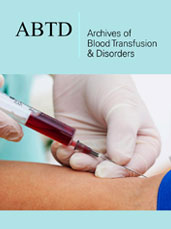- Submissions
Abstract
Archives of Blood Transfusion & Disorders
Evaluation of Liver Iron Concentrations in Children with Beta Thalassemia Infected with Hepatitis C Virus Before and After Spirulina Therapy by Magnetic Resonance Imaging
-
Open or Close El Shanshory MR1*, Awad MA1, El Shafey RA2, Soliman HH3 and Alsharkawy AA4
1Department of Pediatrics, Tanta University, Egypt
2Department of Radiology, Tanta University, Egypt
3Department of Tropical Medicine, Tanta University, Egypt
4Department of Pediatrics, Ministry of Health, Tanta University, Egypt
*Corresponding author: Mohamed Ramadan El Shanshory, Professor of Pediatrics, Chairman of Hematology & Oncology Unit, Pediatric Department, Faculty of Medicine, Tanta University, Egypt
Submission: September 13, 2017; Published: October 24, 2017

ISSN: 2578-0239Volume1 Issue1
Abstract
Background: Magnetic resonance imaging (MRI) assessment of liver iron concentration (LIC) is necessary for the quantitative staging of iron overload in children with β-Thalassemia. There is no enough evidence about the effect of spirulina therapy on LIC.
Aim of the work: To assess LIC by MRI in multitransfused β-Thalassemic children infected with HCV before and after Spirulina Therapy
Patients and methods: Thirty multi-transfused β-thalassemic children infected with HCV, were subjected to clinical evaluation, appropriate laboratory investigations and assessment of LIC by MRI. They were classified according to LIC into mild (group 1) and moderate to severe group (group 2). In addition to standard packed red cell transfusion, Spirulina therapy was given orally for 3 months, after which re-evaluation of these children was performed by repeating the same investigations.
Results: There were significant increases in LIC associated with significant changes in other MRI parameters (significant decrease in T2* and significant increase in R2*) in patients with β-Thalassemia of moderate to severe group as compared to those of the mild group before treatment. The mean values of serum ferritin (SF) were insignificantly higher among patients of mild group. There was no correlation between different MRI parameters and SF level. There were negative correlations between LIC and T2* and positive correlation between LIC and R2*. There was a significant decrease in values of LIC accompanied with significant improvements in SF after spirulina therapy as compared to their pretreatment values in patients of the moderate to severe group.
Conclusion: Spirulina therapy may have favorable effects on lowering the values of LIC in children with β-Thalassemia infected with HCV.
Keywords: Childhood; Iron overload; MRI; Thalassemia
 a Creative Commons Attribution 4.0 International License. Based on a work at www.crimsonpublishers.com.
Best viewed in
a Creative Commons Attribution 4.0 International License. Based on a work at www.crimsonpublishers.com.
Best viewed in 







.jpg)






























 Editorial Board Registrations
Editorial Board Registrations Submit your Article
Submit your Article Refer a Friend
Refer a Friend Advertise With Us
Advertise With Us
.jpg)






.jpg)














.bmp)
.jpg)
.png)
.jpg)










.jpg)






.png)

.png)



.png)






